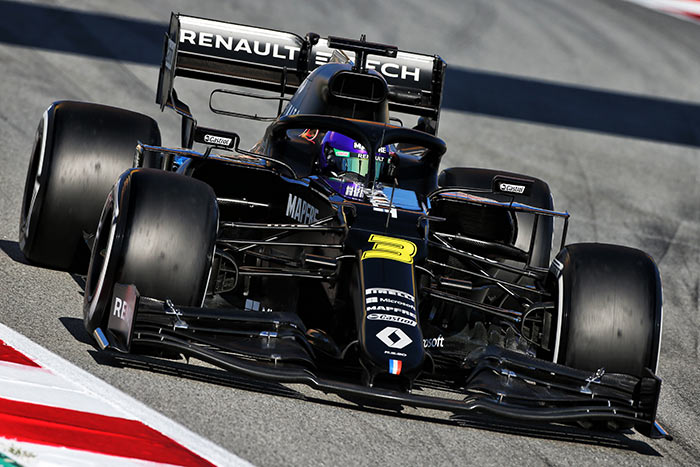Renault Sport R.S.20

Active: 2020
Team: Renault F1
Team: Nick Chester (TD Chassis), Pay Fry (TD Chassis), Rémi Taffin (TD Engine), Vincent Hubert (DTD Engine), Simon Virrill (CD), Steven Booth (DCD), Dirk De Beer (HA), Christian Sol (HAD), Christian Dyer (HVP), Ciaron Pilbeam (CRE), Nico Cuturello (Trackside Operations Manager), Paul Seaby (TM), Alan Permane (SD), Matthew Harman (ED), Rob White (OD), Marcin Budkowski (Exec Director), Matthew Carter (CEO), Cyril Abiteboul (MD), Jérôme Stoll (President), Bob Bell (Tech advisor)
Drivers: Daniel Ricciardo (3), Esteban Ocon (31), Jack Aitken (reserve)
Renault Sport's R.S.20 was left under the covers until the very first day of testing, as the team's launch one week earlier didn't show the car, quite simply because the team weren't ready building it. In fact, some renderings shown at the time revealed a mostly black testing livery to cover up most of the details, while also giving the team more time work on the final race livery as well.
Not much was revealed by the team about the R.S.20, especially not about the chassis, as the team's technical director in charge of the entire development, Nick Chester, left the team at the end of 2019, and was replaced by Pat Fry, who only joined in February 2020. But that was just the top of the iceberg, the team saw many changes in leading positions in the year running up to 2020. Dirk De Beer, for instance, rejoined the team and ousted Peter Machin as Head of Aerodynamics. Matthew Harman, previously deputy CD, moved to be Engineering Director while Steven Booth filled his shoes, moving on from 5 years as Head of suspension design.
Team Cyril Abiteboul said at the team's season launch that there simply was no point in presenting a dummy car, like they had done so repeatedly. Later in testing, the story was already a bit different by admitting that the team hadn't had the smoothest of development programmes for the R.S.20.
On-track performance
Pre-season testing ended up to be fairly positive for the French team, especially in the final few days of the tests when Daniel Ricciardo managed to set the third fastest time of the winter test. Lap time analysis also revealed the team were pretty strong on longer stints, ranking third and 0.7s/lap off Mercedes' pace and just 0.1s/lap slower than rivals McLaren.
Specifications
Chassis: Carbon-fibre monocoque, manufactured and designed in-house
Front suspension: Upper and lower carbon wishbones, inboard torsion springs and dampers actuated by push-rods, aluminium uprights
Rear suspension: Upper and lower carbon wishbones, inboard torsion springs and dampers mounted inside gearbox casing, actuated by pull-rods, aluminium uprights
Dampers: Undisclosed
Brakes: 6 piston front and 4 piston rear calipers with carbon discs and pads (calipers by Brembo, master cylinders by AP Racing)
Transmission: Eight-speed seamless sequential semi-automatic shift plus reverse gear, gear selection electro-hydraulically actuated, carbon maincase
Clutch: Carbon fibre plates
Electronics: FIA standard ECU and FIA homologated electronic and electrical system (as provided by MES)
Cooling system: Aluminium oil, water and gearbox radiators
Tyres: Pirelli
Wheels: OZ Racing, machined magnesium alloy
Fuel system: ATL Kevlar-reinforced rubber bladder
Dimensions
Length: 5425mm
Height: 950 mm (minus T camera)
Track width: 1,600 mm (front); 1,550 mm (rear)
Weight: 746kg (FIA mininum; incl. driver and lubricants, tank empty)
Width: 2,000 mm (FIA maximum)
Powertrain
Designation: Renault E-Tech 20
Type: Turbocharged, 90° 1.6l V6, assisted with kinetic and heat ERS
Valves: 24 (4 per cylinder)
Rev limit: 15,000rpm
Pressure charging: Single turbocharger, unlimited boost pressure (typical maximum 3.5 bar abs due to fuel flow limit)
Bore: 80mm
Stroke: 53mm
Crank height: 90mm (FIA minimum)
Construction: Cylinder block in aluminium
Exhaust: Single exhaust outlet, from turbine on car centre line
Injection: Direct fuel injection, one injector per cylinder, limited to 500bar
Weight: Undisclosed (at least 145kg)
Total horsepower: More than 950bhp (as claimed by Renault Sport)
Energy recovery system: Energy Recovery Systems incorporating two motor generator units – the MGU-H, recovering energy from the exhaust and the MGU-K recovering energy from braking
Energy Store: Battery solution (up to 4MJ per lap), between 20 and 25 kg




